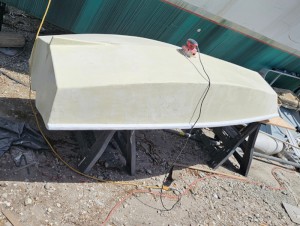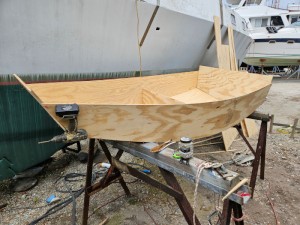Kaimusailing
s/v Kaimu Wharram Catamaran
| Vessel Name: | Kaimu |
| Vessel Make/Model: | Wharram Custom |
| Hailing Port: | Norwalk, CT |
| Crew: | Andy and the Kaimu Crew |
| About: | Sailors in the Baltimore, Annapolis, DC area. |
17 April 2024 | St Marys, GA
Dinghy Skeg
I was suffering with what seemed like a cold and also had allergy symptoms. I awoke and felt fine. The green pollen that was coating everything was gone. Maybe it will return.
07 April 2024 | St. Marys, GA
Clammy Hands
Items came in from TEMU, the Chinese cut rate retailer. One was a nice little drone that cost about twelve and a half dollars. It looked like an easy thing to play with while I coughed and sneezed. I was fighting a summer cold, even though it is not summer elsewhere, it seems like it here. A nice [...]
02 April 2024 | St. Marys, GA
Sun Doggie
After laminating the cedar strips onto the gunwales of the dinghy I found the screws I used wouldn’t come out. The epoxy had seized them. The screw heads were stripped so I cut a straight slot in the heads with the cut off wheel. The cedar smoked when the screw heads got red hot. I could remove [...]
21 March 2024 | St. Marys, GA
Just Add Water
The rainy weekend started off with overcast and fog but no rain. It looked like I might be able to get something done on the D4 dinghy. I wanted to change the bow seat which is really the bow deck. The sailing option uses the deck to hold the freestanding mast. I didn’t like how the deck looked, [...]
01 March 2024 | St. Marys, GA
D4 Dinghy Alternative Seats
The rain event was more wind than rain, strong winds with gusts up to 44 mph. We drove into town to see what the harbor was like. There was a small sailboat that had dragged anchor and was sitting close to shore. The tide was out. We left and played with Bleu at Notter’s Pond.
23 February 2024 | St. Marys, GA
D4 Inside Seams
Day two of the dinghy build started out with me finishing wiring the hull bottoms together on the centerline of the bottom panels. This was much easier than the wiring of the chine edges of the bottom panels and the side panels.
Calabash Creek to Southport, NC

.
Next I connected the fuel line to the main tank which hasn’t been used yet. Full of 20 gallons of old fuel. I started the engine and it ran smoothly. Later its idle began running high and I knew the idle jets that were clogged were now unclogged. I stopped the engine and used needlenosed pliers to remove the blob of JB Weld that I had used to create a higher idle setting which was not needed now. I pulled up the anchor by hand, a very strenuous task.
.
The engine had been running well on the old gas and I let it run for quite a while before we actually got underway. We got about 200 feet and there was a strange sound from the engine. Knowing that sound, I shut the engine immediately. It was the sound of the engine tilting up on its own and thus bringing the prop and the lower unit out of the water.
.
We were about to slide into the ICW main channel from the side channel of Calabash Creek, so I reluctantly put the anchor over and we were secure, but facing a conundrum. The tilt relay or contactor is located under the engine cover and the engine cover can’t be removed when the engine is tilted all the way up. This problem of engine tilting up on its own has happened a couple of times on this trip already, but it always seemed to clear itself. This time it didn’t.
.
I waited, maybe there was moisture making contact and setting the relay to tilt up. Finally I decided, a brilliant decision, to reverse the battery contacts, thus the tilt motor would rotate the other way and the engine would tilt back down. What a genius! Afterwards nothing happened, no tilt up or tilt down. I couldn’t remove the engine cover, but I could loosen it and try to fiddle with things through a two inch gap between the cover and the engine. I pulled out one of the wires, it was the fuse for power to the engine, it was only half of the fuse holder. I kept fiddling. No other half of the fuse holder. Perhaps I could see better and fiddle around better if I was in the dinghy parked next to the engine.
.
I was getting hot from all this work, so I took a break and made a dinghy lifting harness out of some old dynema. It took about 15 minutes. Meanwhile I’m parked next to this nautical intersection and the traffic was heavy, jet skis, fishing boats, shrimp trawlers, Big M Casino vessels which are large, and numerous pontoon boats populated with beings from the Carolina Low Country.
.
In the dinghy I went around to the engine and found the wakes of the passing vessels made it dangerous to be under the swimming ladder, but I managed. Alongside the engine, yes it was easier to see and grab at the wires. There was the other half of the fuse holder, just out of my view from above, I removed the fuse and it looked blown. Back on board I looked around for my box of fuses. Common sense would have me rifle through the electrical toolbox, but that is a chore, it is in a pile of tool boxes underneath the big hatch over the port bunk, which is now like a hardware store attic. I ended up finally going there and finding the correct fuse, then back in the dinghy and over to the engine, install the fuse and repack the wiring so it won’t get pinched by the engine cover. I also noted that one of the terminals on the tilt relay had its rubber boot dislodged. Perhaps that might have something to do with the tilt up command and there is a bare connector that may have contacted that terminal.
.
Now things were going again, tilt up and down, engine fired up and purring like a sewing machine. The dingy was hauled aboard again, the anchor was hauled up again, whew. We were underway and it was 12 noon. We settled into a fast trot at around 6 1/2 knots aided by the inflowing tidal current.
.
The uneventful motor voyage had begun. I put a mark at Southport, to the East, and clicked on navigate to here, then clicked on the vector and selected activate. The inset showing VMG and distance to go and ETA appeared on the right edge of the electronic chart on the Getac computer, which I was using because it has a daylight viewable screen. I found that it needs to be plugged into power when using the high brightness function or it will go dead in about an hour and a half.
.
We had 50 miles to go to Masonboro Inlet, but I intended to stop at a fuel and transient marina at the end of Snow’s cut, about halfway. I began to notice a peculiar effect, we would be aided or impeded by tidal currents as we transited the ICW. Each inlet to the sea was letting the tide run in, so if you were between two inlets there would be tidal inflow coming at you from both directions. Whichever inlet you were closest to, that would be the tidal current that affected you. So our speed would drop to around 4 knots, then later be up to 6 1/2. It all averages out, I guess.
.
The new fuel tank has a gauge and I was surprised to see it down to a half tank and we had 15 miles more to Southport, on the Cape Fear River. That would mean we had burned 10 gallons of gas and I had thought the fuel tank would take us all the way to Masonboro, 50 miles, on economy mode, and we were running at economy mode speeds. The gauge has to be wrong.
.
When the gauge got down to empty we were about 8 miles from Southport. I decided to burn up all that old gas and see how much fuel was left in the tank when it said empty. I was guessing a lot.
.
We had burned 20 gallons of fuel in a little over 5 hours. 4 gallons per hour. I and others running catamarans with similar engines regularly got about 1 1/2 gallons per hour at about 5 knots. I will have to try to duplicate my economy mode or we will be stopping for fuel very often.
.
The tide current in the Cape Fear River is such that going up river against it is a waste of time and fuel. We had run the main tank dry at about high water, so now it would be going against that big current, plus it was after 5 PM, so I called it a day, threw the anchor over, and made pasta with julienned ham and Prego’s roasted garlic and parmesan white sauce. OK with some black pepper.
.
The photo is of sunset shortly after arrival at Calabash Creek.






